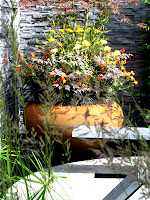 |
| Inspired by Libyan ruins. The handmade hatched texture of the concrete columns and the plant palette call up 50s textiles |
Who wouldn't want to walk to the bench at the end? The uneven floor and the steps would ensure you slowed down and thought about where you're going. A garden's key role is to make you think about where you are going. The whole, aided by a dusty looking mortar and silver-leaved plants, evokes mediterranean heat and having to slow down.
The herbaceous planting focuses on flower head shape: the 'plates' of
Achillea taygetea (mustard yellow that fades - very nice and seen a lot this year), globes of allium, domed umbels of
Anthriscus and
parsnip, spikes of
Camassia and
Stachys, screens of fennel foliage. Brightest red buttons of
Dianthus cruentas sing out (a new plant for Chelsea; Alan Titchmarsh confused it with
D. carthusianorum, which is pink, and which has been in fashion of late with Nigel Dunnett's take on prairie planting). You can't have a show garden without a multi-stemmed tree; in this case
Sophora japonica, which would have great autumn colour and big sculptural seed pods.
 |
| there are 5 all together |
 |
| Sphora japonica, Acanthus mollis 'Rue Ledan' |
 |
| herbaceous planting |



























































